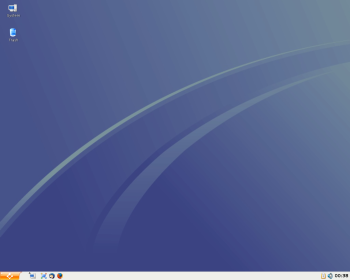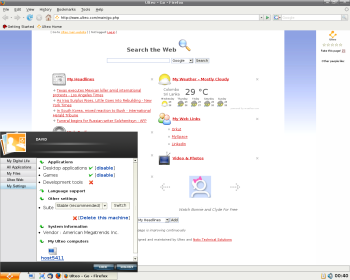Author: Preston St. Pierre
Ulteo Application System is a GNU/Linux distribution based on Kubuntu and designed to work with the Ulteo Online Desktop service to provide you with an automatic offsite backup and file synchronization between live CD instances. It attempts to require as little user configuration and maintenance as possible, and provides several unique features that set it apart from being “just another distribution.”
On my test machine, a Sempron 2800 with 512MB of memory, Ulteo took almost three minutes to boot from the live CD — quite a bit longer than most live CDs take on this system. Ulteo made up for this, however, when copying files during the installation — that took a mere five minutes. There was little user intervention required during the installation besides selection of a username and password and my location, although I chose to partition my disk manually instead of allowing the installer to do it.
Upon the first boot from hard disk, which took a decent 45 seconds, I was prompted to set up the Ulteo Account Association. This requires registration for the Ulteo Online Desktop if you don’t have an account already. Registration is simple and requires little more than an email address, but you may run into problems if you like to use complex passwords. Their system rejected my first two choices as “Unacceptable” when I used characters besides letters and numbers. By associating your system with your Ulteo account, the “sync” folder in the home directory of your local system will be automatically synchronized with the Ulteo server. The amount of data you can sync is limited based on your account type; free accounts are entitled to 1GB of space with a maximum of 10MB transfered per synchronization. Other account types and their prices are listed on Ulteo’s Web site.
The Ulteo Kicker menu is one of the key unique features of the system. It contains five categories: My Digital Life, All Applications, My Files, Ulteo Web, and My Settings. My Digital Life, according to my reading online, is meant to be a sort of organized favorites menu, but it is not fully functional. I was able to add and remove categories from it, but not add any applications, and other users have encountered the same problem. The All Applications menu is exactly what the name says, and looks like the menu you’d find on any other system. My Files is a file browser embedded into the menu; it defaults to your home directory.
The other two menu options are a little more confusing. Ulteo Web has a search bar for multiple sites (Wikipedia, Google, Yahoo, MSN, Amazon and eBay) which opens a new Firefox tab for results. Using this or the toolbar in Firefox to search Google resulted in searches coming up on the custom Ulteo Google page, which is essentially Google with the Ulteo logo and more ads. The confusing part of this bar, though, is the weather. By default, it showed me the weather in Colombo, Sri Lanka. Other Ulteo users report that the weather is set based upon the location you choose during the installation, and I selected Vancouver, Canada. The first two times I attempted to change the location, Kicker crashed. On the third try, it claimed that the location I typed (Vancouver, BC) was invalid. I tried a fourth time using “Vancouver, Canada,” and this finally worked. However, Kicker crashed several more times later when it was displaying the weather menu.
The My Settings menu is limited to a few seemingly unconnected settings. One is language support, a second is the option to switch between Stable, Testing, or Unstable software repositories, and a third touts the ability to “Delete This Machine.” I assume the third means it will remove the machine from the Ulteo online system, but there is nothing (not even a mouseover) to show whether this may be the case. The remaining subcategory inside of My Settings is the confusing part. The Applications subcategory has options for Desktop Applications, Games, and Development. These are all set to disabled by default. While both the former options had “Enable” buttons beside them, the Development option did not, for no apparent reason. I decided to enable both Desktop Applications and Games, expecting to see a lengthy wait as these new categories of applications were downloaded and installed. Instead, the buttons beside them simply changed to a green check mark indicating they were enabled. As far as I have been able to see, no other changes to the system were made. There appeared to be no additional applications or games installed as a result of my changing those settings.
Apart from the custom Ulteo menu and sync folder, the Ulteo Application System is a regular desktop distribution with a decent assortment of common programs. Applications like the GIMP 2.2, VLC 0.8.6c, Amarok 1.3, Firefox 1.5, Kopete 0.12.2, and OpenOffice.org 2.3 cover most of your basic needs. These applications, aside from VLC, are significantly out of date; however, if you need newer versions, you have the ability to upgrade to testing or unstable in the My Settings menu. You can add applications that aren’t installed by default through APT tools easily enough. My hardware was all properly detected, videos and sound played fine, and all the tools I’d expect from a standard distribution were available.
The key feature in Ulteo Application System that makes it unique is the folder synchronization. In addition to allowing you access to your files from any location, it also provides you with an automatic off-site backup. This is a feature that I haven’t seen offered by any other distributions; although there are companies that offer similar features, I have not seen it combined with a complete desktop system. Those who know how and who have access to network servers can set up the same functionality with any other GNU/Linux distribution, but Ulteo provides users who don’t know how with a simple no-headache solution.
Although it has its bugs, the Ulteo Application System is clearly attempting to go in a new direction and separate itself from the masses of other “yet another distribution” distributions. Instead of merely touting “ease of use, stability, and up-to-date programs” as its main features like so many others do, Ulteo claims that these are standard in any modern distribution and attempts to move beyond them. Still, as of this current so-called stable release, it doesn’t appear to be out of the testing stage yet. If you try it out now, be prepared to encounter a few problems.
Categories:
- Ulteo
- Reviews
- Linux
- Distributions




